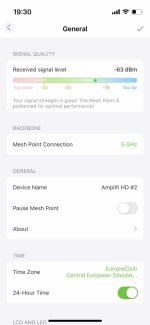Instead of creating a new thread I thought I'd post in here as it's most relevant to my situation.
I'm looking to replace an Orbi RBR50 + RBS50 set up that has been solid for years but recently is starting to show some signs of giving up (mainly satellites just dropping off and having a hard time re-connecting - including the wired ones).
Details:
Otherwise it seems like the TP-Link Deco or Asus ZenWifi offerings are the ones recommended by most. Is that the consensus here? I'm not considering eero because I don't trust the Google ecosystem.
As for budget, it's pretty open. I don't want a budget-oriented system, and I'm willing to pay into four figures for the base + satellites, but I don't want to pay past the point of diminishing returns.
Thanks in advance, folks.
I'm looking to replace an Orbi RBR50 + RBS50 set up that has been solid for years but recently is starting to show some signs of giving up (mainly satellites just dropping off and having a hard time re-connecting - including the wired ones).
Details:
- Cable internet 1000 Mbps / ? up (speed tests show usually 700-900 down / 35-50 up
- Split-level house with service needed to basically 2 stories
- House is not necesssarily big, but it is long, and router can only be on one end of the house
- Two wired runs (CAT5) from the router go to a) the top of the house (straight up) and to the other end of the house
- 4 heavy internet users, from gaming to WFH video, to multiple simultaneous streaming videos, depending on time of day
- Suburbs on a 1/3 acre lot, very rarely see my neighbors' wifi pop up on my phone, so I assume little contention from other networks
- I need the ability to reserve some internal IPs (like in specific for a work printer for my wife) and I'd like to do a little QoS, but I don't have a lot in the way of management needs, although I also wouldn't mind some sort of way of finding out how much bandwidth each device that attaches to my network is actually using, because holy shit do we have a lot of devices (this might be the oldster in me talking, though)
- Drywall throughout, but right in the middle of the house is and oversized concrete chimney stack
Otherwise it seems like the TP-Link Deco or Asus ZenWifi offerings are the ones recommended by most. Is that the consensus here? I'm not considering eero because I don't trust the Google ecosystem.
As for budget, it's pretty open. I don't want a budget-oriented system, and I'm willing to pay into four figures for the base + satellites, but I don't want to pay past the point of diminishing returns.
Thanks in advance, folks.



